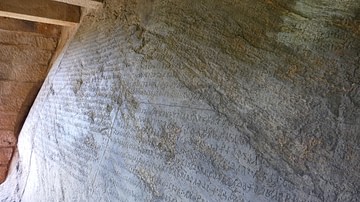
The Mauryan Empire (322 BCE - 185 BCE) supplanted the earlier Magadha Kingdom to assume power over large tracts of eastern and northern India. At its height, the empire stretched over parts of modern Iran and almost the entire Indian subcontinent, barring only the southern peninsular tip. The empire came into being when Chandragupta Maurya stepped into the vacuum created by Alexander of Macedon's departure from the western borders of India. Chandragupta subjugated the border states, recruited an army, marched upon the Magadha kingdom, killed its tyrannical king who was despised by the populace, and ascended the throne. He thus founded the Mauryan dynasty. In his rise to power, he was aided and counselled by his chief minister Kautilya (also known as Chanakya), who wrote the Arthashastra, a compendium of kingship and governance.
Consolidation of power
Chandragupta embarked upon an aggressive expansion policy. Seleucos I Nicator, who was Alexander's satrap for the eastern Macedonian conquests, was defeated and had to cede the entire territory under him to Chandragupta, along with a daughter and considerable money. He also sent Megasthenes, who wrote the Indica, to the Mauryan court as the Greek ambassador.
Chandragupta used marriage alliances, diplomacy, trickery, and war to extend his kingdom. Under him, the Mauryan empire stretched from eastern Iran to the western borders of the Burmese hills, and from the Himalayan tribal kingdom to the southern plateaus of peninsular India. After ruling for about 25 years, Chandragupta abdicated in favour of his son, Bindusara, and became a Jain monk.
Bindusara maintained his father's large dominions efficiently and extended the southern borders to cover the peninsular plateau of India. When he died, his son Ashoka seized the throne after a fratricidal succession dispute. The empire that Ashoka inherited was large, but a small kingdom on the east coast, Kalinga, was outside its pale. Ashoka decided to conquer it. The war that ensued was bloody and long. Kalinga resisted to the last man but fell. After Kalinga, Ashoka did not attack any kingdom but proceeded on a mission of peace. He erected several pillars throughout his kingdom, exhorting people to give up violence and live in harmony with each other and with nature. He actively patronised Buddhism, built several stupas and repaired older ones, and sent evangelical missions abroad, two of which comprised his own son and daughter.

...various animals were declared to be protected — parrots, mainas, aruna, ruddy geese, wild ducks, nandimukhas, gelatas, bats, queen ants, terrapins, boneless fish, vedareyaka, gangapuputaka, sankiya fish, tortoises, porcupines, squirrels, deer, bulls, okapinda, wild asses, wild pigeons, domestic pigeons and all four-footed creatures that are neither useful nor edible. Those nanny goats, ewes and sows which are with young or giving milk to their young are protected, and so are young ones less than six months old. Cocks are not to be caponized, husks hiding living beings are not to be burnt and forests are not to be burnt either without reason or to kill creatures. One animal is not to be fed to another. On the three Caturmasis, the three days of Tisa and during the fourteenth and fifteenth of the Uposatha, fish are protected and not to be sold. During these days animals are not to be killed in the elephant reserves or the fish reserves either. On the eighth of every fortnight, on the fourteenth and fifteenth, on Tisa, Punarvasu, the three Caturmasis and other auspicious days, bulls are not to be castrated, billy goats, rams, boars and other animals that are usually castrated are not to be. On Tisa, Punarvasu, Caturmasis and the fortnight of Caturmasis, horses and bullocks are not be branded.
(Pillar edict)
The successor's of Ashoka were not strong enough to hold the empire together. It started disintegrating bit by bit, and in 185 BCE, almost 150 years after Chandragupta had overthrown the Magadha king, the last Mauryan ruler was assassinated by his commander-in-chief while inspecting his troops.
Economy
Trade and enterprise were public-private affairs: the state could own and engage in business activities just like ordinary citizens could. The royal revenue was drawn from taxes (and war booty). Additionally, the king owned timber land, forest land, hunting groves, and manufacturing facilities, and their surplus was sold off. The state had monopoly over coinage, mining, salt production, arms manufacture, and boat building.
Farmers comprised the largest part of the population, and agriculture was taxed. Tradespeople were organised into guilds that held both executive and judicial authority and also functioned as banks. Craftspeople engaged in a particular industry tended to live together. Goods could not be sold at the place where they were produced; they had to be brought to specific markets. Tolls were collected for roads and river crossings; and goods sold within the kingdom were taxed, as were imports and exports. The state fixed the wholesale price of goods and inspected weights and measures. Barter was prevalent, as were gold, bronze, and copper coins. Money was lent on interest against promissory notes.
The main road that ran through the entire kingdom and connected it to the western Greek world was well maintained and well patrolled, with pillars and signposts marking the distances and the by-roads. Ships sailed down the Ganges and its tributaries, and to foreign shores such as Sri Lanka, China, and the African and Arabian harbours, and the state took care to destroy pirates.
Administration
The king was the head of the state and controlled the military, executive, judiciary, and legislature. He took advice from a council comprising the chief minister, the treasurer, the general, and other ministers. The kingdom was divided into provinces under governors, who were often royal princes. Provinces were further composed of towns and villages under their own district and village administrators. It was a large bureaucracy that the king employed. Like today, the rungs in the civil services were clearly defined, and those at the very top were far removed from the lower grades. For example, the ratio of a clerk's salary to the chief minister's has been estimated at 1:96. With such high levels of salary, we can assume that the higher officers were expected to carefully oversee the functioning of their departments.
There were departments to govern, look after, and control almost every aspect of social life: industrial art, manufacturing facilities, general trade and commerce, foreigners, births and deaths, commercial taxes, land and irrigation, agriculture, forests, metal foundries, mines, roads, and public buildings. The high-ranking officers were expected to go on inspection tours to ensure that the bureaucracy was discharging its duties well.
He who causes loss of revenue eats up the king's wealth, he who produces double the [anticipated] revenue eats up the country, and he who spends all the revenue [without bringing any profit] eats up the labour of workmen.
(Arthashastra, 2.9.13, 15, 17)
The empire also had a large spy network and maintained a large standing army. The king's army was not really disbanded even after the third Mauryan king, Ashoka, gave up war. Next to the farmers, it was the soldiers who formed the bulk of the population. Soldiers were expected to only fight and were not required to render any other service to the king; when there was no war, they could amuse themselves in whatever manner that caught their fancy. There were separate departments for the infantry, cavalry, navy, chariots, elephants, and logistics. Soldiers not only drew their salary from the exchequer but were also provided with arms and equipment at the state's expense. We have descriptions of some of the arms that these soldiers carried: foot soldiers carried man-length bows (and arrows), ox-hide bucklers, javelins, and broadswords. The cavalry rode bareback and used lances and bucklers.
... nor do they curb them with bits like the bits in use among the Greeks or the Kelts but they fit around the extremity of the horse's mouth a circular piece of stitched raw ox-hide studded with pricks of iron or brass pointing inwards, but not very sharp. If a man is very righ, he uses pricks of ivory. Within the horse's mouth is put an iron prong like a skewer to which the reins are attached. When the rider, then, pulls the reins, the prong controls the horse and the pricks, which are attached to this prong, goad the mouth...
(Indica)

Religion
Chandragupta, the founder of the Maurya dynasty, was a Hindu. In later life, he became a Jain. His grandson Ashoka put the state's entire resources to promote Buddhism, but whether he formally converted to the faith remains unclear. The populace, by and large, belonged to one of these three religions while other noticeable groups were atheists, agnostics, or those who subscribed to primitive faiths.
Downfall
About 50 years after Ashoka's death, the Mauryan king was killed by his general-in-chief, Pushyamitra, who founded the Shunga dynasty. Scholars give several reasons for the empire's downfall, the major ones being its size and its weak rulers after Ashoka. Border states had started asserting their independence right after Ashoka's death. The empire started shrinking under Ashoka's successors. By the time Pushyamitra seized the throne, the mighty Mauryan Empire was a fraction of its size, reduced to only the three city-states of Pataliputra, Ayodhya, and Vidisha, and some parts of the Punjab.








